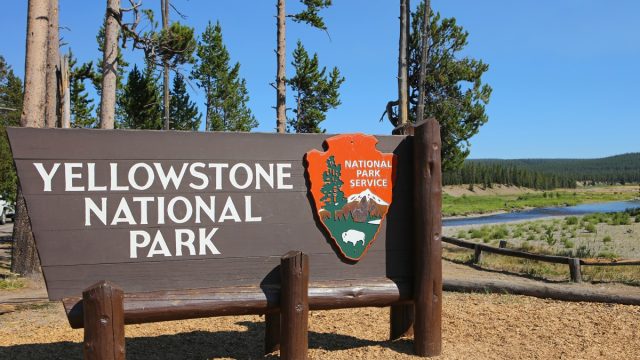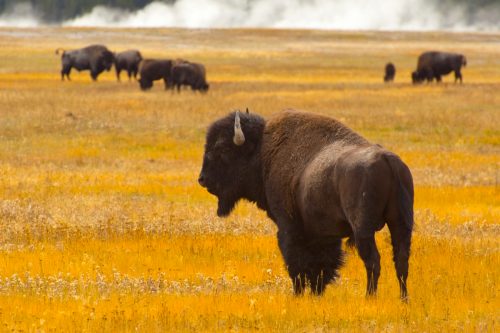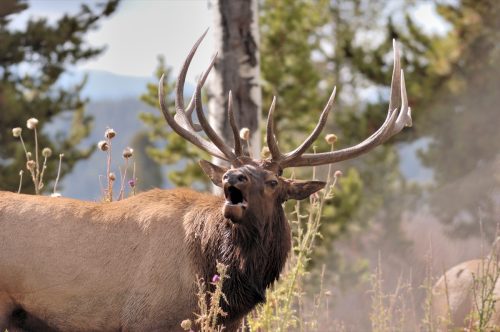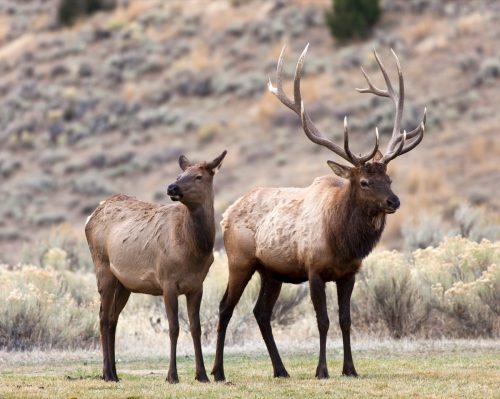Yellowstone National Park Rangers Urge Caution Near This “Unpredictable” Threat

If you’re booking a trip to a U.S. national park, you’re probably up for a bit of adventure. But while these parks offer a great opportunity to explore some amazing natural wonders, they aren’t without their dangers. There are fall hazards, risks of drowning, and potential car accidents if you’re driving through. At Yellowstone National Park—one of the country’s most popular destinations—park rangers work to ensure visitors stay safe during their explorations. However, there is one threat that’s notably “unpredictable.” Read on to find out what park rangers just issued a new warning about.
READ THIS NEXT: Yosemite National Park Officials Say If You Hear This, “Quickly Get Away From the Area.”
Earlier this summer, visitors were asked to be mindful of bison.

Of the many sights at Yellowstone, visitors often look forward to seeing wildlife in action. But wildlife is just that, and park rangers ask that you actively protect both the park and yourself. Risks increase depending on when you visit, and last month, park rangers reminded visitors about bison.
Every summer, bison begin their mating season, or “rut,” where they “congregate in large herds to compete, socialize, and eventually breed,” officials said in an Aug. 19 Facebook post. Males will mate with several females from mid-July through September.
“It’s important to remember that during rut, bulls are on high alert and can get aggravated easily! No matter what time of year, always stay further than 25 yards away from all wildlife, and make sure both tires are over the white lines if you pull off the road to view them,” officials said.
Now, park rangers are warning about another animal beginning its mating season at Yellowstone.
One species is much more dangerous in the fall.

There are several changes as summer ends and autumn arrives, including cooler temperatures and beautiful foliage. But with the arrival of September, Yellowstone park rangers warn that elk are also going through a transition during this time. As a result, they become increasingly aggressive.
“WARNING: Bull elk in Yellowstone can be unpredictable and dangerous during fall mating season,” the park tweeted on Sept. 7. “The elk mating season, commonly referred to as the rut, has begun in the park.”
The rut generally begins in September and continues through October, according to the park’s page describing elk. And as male elks (bulls) weigh up to 700 pounds and females (cows) weigh around 500 pounds, you won’t want to tussle with one.
RELATED: For more up-to-date information, sign up for our daily newsletter.
Elk can direct their aggression at visitors.

A clear indicator that mating season has arrived is “bugling,” wherein a bull elk will make a call to “announce their availability and fitness to females and to warn and challenge other bulls,” per the elk description page. When the bugle is answered, males will migrate towards each other and sometimes battle for the right to mate with a certain female.
“They crash their antlers together, push each other intensely, and wrestle for dominance. While loud and extremely strenuous, fights rarely cause serious injury. The weaker bull ultimately gives up and wanders of,” the page reads.
Unfortunately, amid all of this action, these large animals may also direct their aggression on humans. “People have been severely injured by elk,” a Sept. 7 news release from Yellowstone states. “Elk run quickly and may change direction without warning.” The general Yellowstone safety page adds that elk will charge both cars and people if they get “too close.”
Take these steps to protect yourself.

Elk tend to congregate around the popular Mammoth Hot Springs at this time, Brad Bulin, wildlife biologist and Yellowstone guide and author, told Newsweek in August. This “creates big problems because there are so many people coming and going in Mammoth Hot Springs that the park has to bring in a lot of staff at that time of year to prevent people getting too close to these aggressive bulls, which can smash into their cars or chase people, or gore people,” Bulin said.
To avoid ending up in this situation, park rangers stress the need to stay a minimum of 25 yards (roughly the length of two buses) away from elk, and safely view wildlife from inside your car. “Never approach or pursue animals to take their picture,” the Sept. 7 press release states. “Zoom lenses with focal lengths up to 300 or 400mm offer a great combination of portability and reach.”
But in the event an elk does charge at you, you will want to get out of its way—fast. “Quickly find shelter in your vehicle or behind a tall, sturdy barrier,” per the press release. “Run away if nearby shelter is not available.”